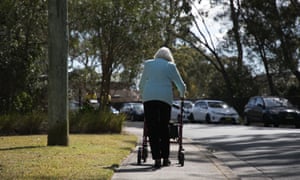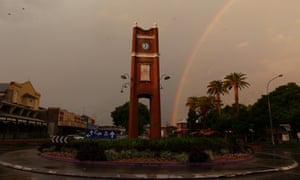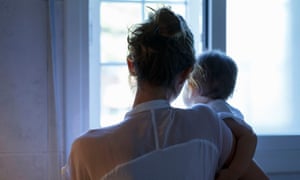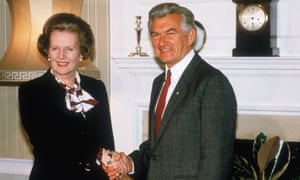Extract from The Guardian
How did we get here, and why does Australia, allegedly the land of
the fair go, fail to make progress on lifting the bottom 10% out of
poverty?
Ronald
Henderson, the chair of Australia’s only comprehensive inquiry into
poverty, had what a friend called “an offended conscience”. His inquiry,
whose main report was released a few months before the Whitlam
government was dismissed in 1975, did as much as any single act before
or after it to prick the bubble that Australia was a country of the fair
go for all.
To read it is to be struck by how much has changed – women have poured into the workforce, we have been buffeted by globalisation and a rise in precarious employment – but also how much has stayed the same. Henderson insisted that poverty was a moral question. “Poverty is not just a personal attribute: it arises out of the organisation of society,” he said, a statement at the heart of the tension over poverty today. And a few years later: “For some 2 million people, including over three quarters of a million children to be left in deep poverty in this rich country is a disgrace.”
Australia’s peak body for community services organisations, the Australian Council of Social Service (Acoss) routinely calls our persistent poverty rates disgraceful, its Poverty in Australia report last year finding that 3 million of us, or just over 13%, live in poverty, including 739,000 children. “Poverty is now a consistent feature of Australian life,” said its CEO Cassandra Goldie. “Are we prepared to accept this?”
It seems we are. For decades, poverty and deep disadvantage have been all but absent in our political debate, and it’s unlikely any major political party will make ending or halving or tackling it in any targeted way a “vital national goal”, as Henderson once urged.
It’s as though the word is shameful. John Howard’s government removed references to “poverty” as it introduced its radical welfare reforms. The Rudd and Gillard government’s preferred term was “social inclusion”.
"The latest Hilda survey suggests that 30% of Australians aged 65 or over live in poverty, which is “very high” by OECD standards"
We are the second wealthiest people on earth. Whether the rich are getting richer and the poor poorer is contested, but the productivity commission’s detailed report last year found that income inequality has risen only slightly in the past 30 years.To read it is to be struck by how much has changed – women have poured into the workforce, we have been buffeted by globalisation and a rise in precarious employment – but also how much has stayed the same. Henderson insisted that poverty was a moral question. “Poverty is not just a personal attribute: it arises out of the organisation of society,” he said, a statement at the heart of the tension over poverty today. And a few years later: “For some 2 million people, including over three quarters of a million children to be left in deep poverty in this rich country is a disgrace.”
Australia’s peak body for community services organisations, the Australian Council of Social Service (Acoss) routinely calls our persistent poverty rates disgraceful, its Poverty in Australia report last year finding that 3 million of us, or just over 13%, live in poverty, including 739,000 children. “Poverty is now a consistent feature of Australian life,” said its CEO Cassandra Goldie. “Are we prepared to accept this?”
It seems we are. For decades, poverty and deep disadvantage have been all but absent in our political debate, and it’s unlikely any major political party will make ending or halving or tackling it in any targeted way a “vital national goal”, as Henderson once urged.
It’s as though the word is shameful. John Howard’s government removed references to “poverty” as it introduced its radical welfare reforms. The Rudd and Gillard government’s preferred term was “social inclusion”.
"The latest Hilda survey suggests that 30% of Australians aged 65 or over live in poverty, which is “very high” by OECD standards"
The commission concluded that three decades of economic growth – the envy of the world – had “delivered for the average Australian household in every income decile significantly improved living standards”, mainly due to our progressive tax system and our highly targeted transfer system – unlike many countries, the vast bulk of government social spending is directed to those who need it most.
“It has varied a bit throughout that period but today, for 2 million or so people, we are where we were 30 years ago” and on some measures, child poverty had gone backwards. Harris threw out a challenge to politicians and policy makers: give this your attention, because what we have been doing for decades is not working.
Even discussing poverty is hard because we have no agreed definition. Our federal government doesn’t regularly monitor or report on it, or set targets to reduce it, meaning there’s no accountability. Canada has a strategy to halve poverty by 2030. Recent figures show it’s working – between, 2015 and 2017, the poverty rate was cut by at least 20%, and Canada now has its lowest poverty rate in history.
New Zealand has recently set a 10-year goal to halve the child poverty rate.
The standard OECD measure is relative income poverty, which is set at 50% of median household income after tax (if you earn the median, you’re in the middle – half the population earns more, half less) around $433 a week for a single person, – or about $24,000 a year. For a couple with two children, it’s $909 a week.
There are other measures – Acoss takes into account housing costs, and estimates that 13.2% of us are below this poverty line, and 17.3% of children – or one in in six – live in poverty. The Hilda survey collects information every year from about 17,000 Australians and has found that although poverty here remains higher than the OECD average, it has decreased slightly in recent years.
Over time, there have been attempts to broaden the idea of poverty and disadvantage beyond the blunt measure of income. The Brotherhood of St Laurence’s social exclusion monitor estimates that about 5% – more than 1 million people – experience deep exclusion, which means at least four different sorts of overlapping disadvantage at once, such as low income, little work experience, poor health and education or an inability to partake in community life.

Whichever measure is used, there is little debate about who is more likely to be poor and disadvantaged in Australia. The productivity commission found that we are remarkably mobile by international standards – we move up and down the income ladder throughout our lives. We leave school or university and find jobs, we lose our jobs and find new ones, we have children, we get divorced, we retire. Sometimes we have more money, sometimes less.
But at the very top, and the very bottom, there is less mobility, it’s more “sticky”, as they put it, which means if you are very poor, you are more likely to stay that way, or if you escape poverty, you are more likely to fall back into it. Around 3% of Australians, or 700,000 people, have been in income poverty for at least the last four years. The evidence is that the longer you live in poverty, the harder it is to get out of it.
Using Acoss figures on family type, sole parent families have the highest poverty rates at 32%. Children in those families, with a poverty rate of 39%, are more than three times as likely to live in poverty as children living in couple families.
Unsurprisingly, if you are unemployed you are much more likely to live in poverty. Almost 55% of people on Newstart, the main unemployment benefit, are in poverty, and it’s even higher for those young people aged 18 to 24 living out of home on the Youth Allowance. Being unemployed means deep poverty – those on Newstart are not close to any poverty line, on Acoss’s estimation, they are $175 a week below it.
Australians over 65 also face poverty, but here the impact of housing is stark. There has been a reduction in aged poverty in recent years – largely due to the Rudd government’s increase in the pension for single people on the aged pension in 2009 – and if you own your own home, and have solid superannuation, you most likely avoid it. But the 10% of older Australians who rent have a poverty rate of 43%. The latest Hilda survey suggests that 30% of Australians aged 65 or over live in poverty, which is “very high” by OECD standards.
There’s overlap in all this. About 17% of adults with a disability live in poverty, although that’s likely to be an underestimate. About a quarter of people on the Newstart payment have a disability.

A study released last year found that Indigenous poverty rates have declined slowly over the past decade from almost 34% in 2006 to 31.4% in 2016, still far higher than the overall population. It rises the further you go from major urban centres – it’s close to 70% in Nhulunbuy in the NT, but 19% in the ACT and 21.3% in Melbourne.
Poverty is concentrated. It’s higher in our regional and remote areas, but it’s growing in sprawling outer suburbs, too. The Brotherhood of St Laurence’s recent compiling of “hot spots” found a youth unemployment rate of more than 25% in the Queensland areas of Cape York, Weipa and Mt Isa and 23.3% in the Coffs Harbour-Grafton region of NSW.
In Australia, our poverty rate is stuck, our “debate” about it moribund and depressing, all but non-existent apart from earnest panel discussions and enraged reports from welfare groups and experts. Talk to those who have followed these issues for decades and they will explain how we got here, and how the evidence as to what will work is so often ignored.
“There are many layers to it,” says professor Shelley Mallett, general manager of research and policy with the Brotherhood of St Laurence. “The top-level layer is the one about attitudes and political will.”
Perhaps it goes deeper than politics. Dutch historian Rutger Bregman suggests in the phenomenally successful Utopia for Realists that incredibly prosperous countries like ours have stopped believing in big ideas like ending poverty.
“Time and again,” he writes, “We blame collective problems like unemployment, dissatisfaction, and depression on the individual. If success is a choice, then so is failure. Lost your job? You should have worked harder. Sick? You must not be leading a healthy lifestyle. Unhappy? Take a pill.”
“The politics of all this has been quite nasty and difficult,” says Jacqui Phillips, Acoss’s director of policy and advocacy. “There’s been a lack of courage to challenge the stereotypes around who is on income support and a real desire to both sides of politics to be seen to be incredibly tough on people, particularly those who are unemployed.”
According to Professor Roger Wilkins, University of Melbourne economist and lead author of the Hilda report, “we’ve spent probably 20 to 25 years unpicking the system, undermining it, winding it back”.
Our social security system is one of the biggest levers we have to reduce poverty. At least since the 1990s, our system has been tightened, particularly for the unemployed, with ever-more hoops to jump through, and compliance rules and penalties for the smallest transgression.
There’s now a perversity in our system, with rules supposed to help people “bounce” out of poverty seemingly doing the opposite.
It’s not that the principles of terms such as “reciprocal obligation’ or “welfare to work” or “mutual obligation” are not defensible, but they have been distorted to the point where it is not only welfare groups saying they are broken. The Business Council of Australia has been saying for years that unemployment benefits must rise, because they “may now be so low as to represent a barrier to employment”.
There’s a myth that only a tiny percentage of us will ever use our social security system. Hilda data shows that 64.3% of those of us of working age either received some income support payment ourselves or lived in a house where someone did in the 10 years to 2010.
It is there for most of us, and it is meant to be a safety net to assist people get back on their feet. But too often it’s not. “It has unintended consequences,” says Mallett. “It’s actually driving people into poverty and it’s keeping them in poverty.”
The perversity threads through our system. Twenty years ago, we became the only OECD country to outsource to private operators the delivery of our publicly-funded employment services – those that are meant to help the unemployed into work. It’s called Jobactive, costs $1.3bn a year and it’s failing in its purpose.
According to a recent Labor-chaired Senate inquiry report, demoralised staff with an average of 150 clients each had too little time to help the jobless in a meaningful way, spending too much time on “compliance”. Most job seekers have to apply for 20 jobs a month (the government has recently announced plans to relieve this burden) and are issued “demerit” points, often for minor transgressions which can mean a suspension of payments.

Something is wrong when by the end of last year, 42.5% of the Jobactive caseload had at least one “demerit” resulting in payment suspension and more than half of all Indigenous participants were issued a “demerit”. Something is wrong when, during 2015-16, about half of the penalties imposed were later found to be in error, so almost 1 million people were punished when they had done nothing wrong.
The government says the system isn’t perfect – it recently announced changes, including a new digital-focus – but insists it is steering people into work, with Jobactive assisting 1.1 million people into jobs since 2015. But the evidence is there that job seekers often get work despite, not because of, the service meant to serve them.
It’s a similar story with single parents. In 2006, the Howard government as part of its “welfare to work” changes, moved anyone claiming the benefit after that date to the much lower Newstart payment when their youngest child turned eight. In 2013, the Gillard government got rid of the 2006 cut-off date, which meant another 80,000 single parents with older children were moved to Newstart and required to look for work.
These are the current flashpoints, but you have to go further back to understand the undercurrents that have brought us here. Australia introduced old aged and invalid pensions, as they were called, in 1908. Child endowment – the precursor to family benefits – started in 1941, and unemployment payments in 1944, a response to the yearning for “social security” after the mass joblessness of the depression.
Then there was the “golden age”, the decades when unemployment wasn’t a problem, sitting at 1 or 2%. Incomes grew strongly, being out of work was seen to be temporary, and it was the role of government to provide jobs.
Henderson reported in 1975, the beginning of huge economic and social upheavals. Unemployment rose along with inflation and the complacency that being out of work was a temporary thing frayed. Prime minister Malcolm Fraser spoke of “dole bludgers” as the moral blame for joblessness shifted to individuals. Margaret Thatcher said in western countries poverty was a “personality defect”.
For all the faith in the free market, for all the language around individual responsibility, what governments have done has mattered. What did more than anything to reduce poverty for older Australians was the Rudd government’s 2009 decision to increase the pension for single, aged people by $32 a week. An Acoss report found the relative poverty rate (before housing costs) for people aged 65 and over fell from around 30% in 2007-08 to 11% in 2013-14, due to the “historic increase” in pension rates.
Bob Hawke’s famous declaration in 1987 that that “by 1990 no Australian child will be living in poverty” might have been foolish, but his government, led by social security minister Brian Howe, made tangible and successful strides to reduce it, providing evidence that in a rich country we choose the level of poverty we are comfortable with. The package’s core principle was that payments should be enough to assist a family with a low income or no job pay the basic costs of raising a child. In three years, child poverty reduced by 30%.
What also began in the Hawke-Keating years was the idea of “reciprocal obligation” or “activation”, a catch-phrase taking hold across the developed world. It has always been a requirement for someone on unemployment benefits to look for work in Australia, but Hawke and Keating, worried about the rate of joblessness and the increasing time people spent on benefits, began the trend to increase the obligations of those out of work. There was a legitimate fear, too, that welfare dependency itself was psychologically harmful and demoralising.
"Australia has one of the highest under-employment rates in the world"
Newstart, introduced in 1989 (then for those unemployed for 12 months or more), provided more intensive work requirements and referrals to training and labor market programs. At the same time, Labor increased the level of unemployment benefits, and poured hundreds of millions into industry and training programs.
The reason, say Phillips and others, is that our system works to distinguish between the “deserving” and the “undeserving” poor, the deserving being those on aged and other pensions, and the undeserving being the unemployed.
It was the Howard government that benchmarked pensions to average weekly earnings in 1997, but kept “allowances” such as unemployment payments pegged to increases in inflation. For 25 years, there has been no real increase in Newstart, while aged pensions have kept up with average living standards. The result is that Newstart keeps falling behind – it is just $280 a week for a single person – driving more people into deep poverty.
Labor is promising a review of payments such as Newstart, but won’t commit to increasing it before the election. Welfare groups point out that Labor has put energy into services more than income – Medicare, the NDIS, increased funding for schools that need it most – but both major parties routinely use the mantra that “the best welfare is a job”.

“What’s happened,” says professor Peter Saunders, from the social policy research centre at the University of New South Wales, “is that the political class have taken this idea that work is good for you, and interpreted it to mean that we can do anything to people not in work and that is defensible because some of what we do might end up with some of them ending up in work. What we’re doing basically is conducting a series of social experiments on the most disadvantaged people.”
Then there’s under-employment, a fairly new and growing problem – Australia has one of the highest under-employment rates in the world.
According to the Australian Bureau of Statistics, since the global financial crisis the number of workers who are working part time and wanting more hours has climbed from about 680,000 to 1.1 million, from 6.3% to 8.9% of the workforce. People can work in casual or insecure work and still live in poverty – they are the working poor.
If we want to do something about poverty in Australia, there are the urgent solutions and the longer, harder ones. Increasing Newstart would have an immediate impact, but it would only be a catch-up. Researchers such as Saunders say it may take another Henderson-style inquiry, a fresh look at what poverty looks like in 2019. Reducing the number of Australians living in poverty will take far more than political commitment, but it can’t happen without it. Political commitment will only come, perhaps, once the public cares. Whether, collectively, our conscience is offended by poverty, or not.
This reporting is supported by VivCourt through the Guardian Civic Journalism Trust

No comments:
Post a Comment